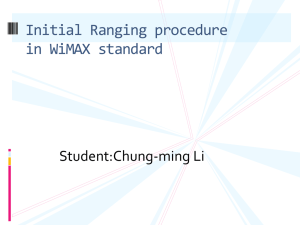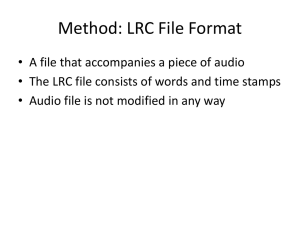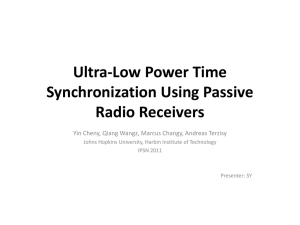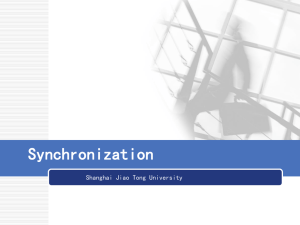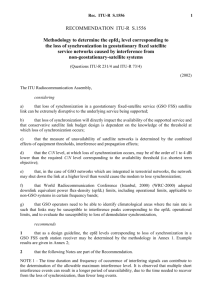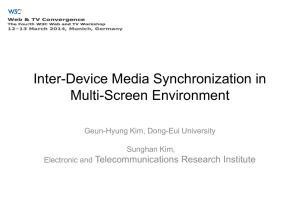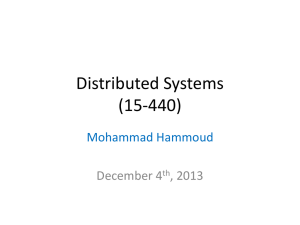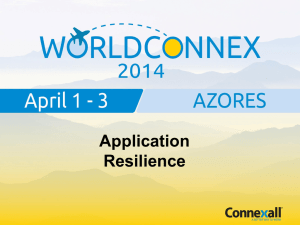Lecture
advertisement
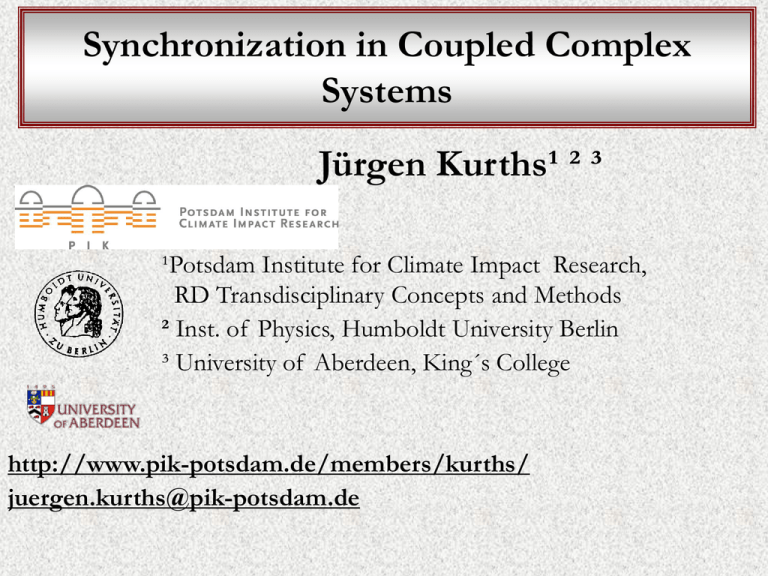
Synchronization in Coupled Complex Systems Jürgen Kurths¹ ² ³ ¹Potsdam Institute for Climate Impact Research, RD Transdisciplinary Concepts and Methods ² Inst. of Physics, Humboldt University Berlin ³ University of Aberdeen, King´s College http://www.pik-potsdam.de/members/kurths/ juergen.kurths@pik-potsdam.de Outline • Introduction • Complex synchronization in simple geometry – Phase-coherent complex systems – Applications • Synchronization in non-phase coherent systems: phase and/vs. generalized synchronization - Concepts of curvature and recurrence - Applications • Conclusions Nonlinear Sciences Start in 1665 by Christiaan Huygens: Discovery of phase synchronization, called sympathy Pendulum Clocks • Christiaan Huygens: Pendelum clocks hanging at the same wooden beam (half-timber house) It is quite worth noting that when we suspended two clocks so constructed from two hooks imbedded in the same wooden beam, the motions of each pendulum in opposite swings were so much in agreement that they never receded the last bit from each other...Further, if this agreement was disturbed by some interference, it reastablished itself in a short time...after a careful examination I finally found that the cause of this is due to the motion of the beam, even though this is hardly perceptible (Huygens, 1673) Examples: Sociology, Biology, Acoustics, Mechanics • • • • Hand clapping (common rhythm) Ensemble of doves (wings in synchrony) Mexican wave Menstruation (e.g. female students living in one room in a dormitory) • Organ pipes standing side by side – quenching or playing in unison (Lord Rayleigh, 19th century) • Fireflies in south east Asia (Kämpfer, 17th century) • Crickets and frogs in South India Necessary Conditions for Synchronization • Two Oscillators (or more; best: self-sustaining) • Coupling: Master – Slave, or mutually coupled • Starting: (slightly) different systems (initial conditions, internal frequencies) • Goal: becoming identical in a main property or sharing some important behaviour due to forcing or interaction (becoming identical, adjusting their phases…) Types of Synchronization in Complex Processes - phase synchronization phase difference bounded, a zero Lyapunov exponent becomes negative (phase-coherent) (Rosenblum, Pikovsky, Kurths, 1996) - generalized synchronization a positive Lyapunov exponent becomes negative, amplitudes and phases interrelated (Rulkov, Sushchik, Tsimring, Abarbanel, 1995) - complete synchronization (Fujisaka, Yamada 1983) Phase Synchronization in Complex Systems Most systems not simply periodic Synchronization in complex (non-periodic) systems Interest in Phase Synchronization How to retrieve a phase in complex dynamics? Phase Definitions in Coherent Systems Rössler Oscillator – 2D Projection Phase-coherent (projection looks like a smeared limit cycle, low diffusion of phase dynamics) Phase dynamics in periodic systems • Linear increase of the phase φ (t) = t ω ω = 2 Π / T – frequency of the periodic dynamics T – period length φ (t) increases 2 Π per period d φ (t) / d t = ω Phase Definitions Analytic Signal Representation (Hilbert Transform) Direct phase Phase from Poincare´ plot (Rosenblum, Pikovsky, Kurths, Phys. Rev. Lett., 1996) Synchronization of two coupled non-identical chaotic oscillators Phases are synchronized BUT Amplitudes almost uncorrelated Two coupled non-identical Roessler oscillators Equation for the slow phase θ: Averaging yields (Adler-like equation, phase oscillator): Synchronization threshold Fixed point solution (by neglecting amplitude fluctuations) Fixed point stable (synchronization) if coupling is larger than Problems with phase jumps • Phase synchronization: difference of phases of two (more) subsystems is bounded • Phase jumps of +/- 2 Π occur due to - at the borderline of synchro region - influence of noise (Stratonovich) - broad variety of unstable periodic orbits, as in the Lorenz system (deterministic effect) imperfect phase synchronization (Zaks, Park, Rosenblum, Kurths: Phys Rev Lett 1999) Cyclic relative phase • How to consider this problem? • Phase synchronization in a statistical sense • Instead of the strong condition We consider the cyclic relative phase And analyze the frequency distribution of the cyclic relative phase Criteria for phase synchronization - 1 (Phase) Synchronization – good or bad??? Context-dependent Applications in various fields Lab experiments: • Electronic circuits (Parlitz, Lakshmanan, Dana...) • Plasma tubes (Rosa) • Driven or coupled lasers (Roy, Arecchi...) • Electrochemistry (Hudson, Gaspar, Parmananda...) • Controlling (Pisarchik, Belykh) • Convection (Maza...) Natural systems: • Cardio-respiratory system (Nature, 1998...) • Parkinson (PRL, 1998...) • Epilepsy (Lehnertz...) • Kidney (Mosekilde...) • Population dynamics (Blasius, Stone) • Cognition (PRE, 2005) • Climate (GRL, 2005) • Tennis (Palut) Synchronization in spatially extended systems Chain of diffusively coupled Roessler oscillators Possible Artefacts • • • • Superimposed signals (EEG...) Cocktail-party problem (source separation) ICA - independent component analysis Temporal decorrelation separation method very necessary as a 1st step (before synchronization analysis) to avoid pitfalls Cognitive Experiment Press a key 2 s Activity: -500 ... 300 ms Synchro effect in mu-band (11 Hz) Meinecke, Ziehe, Kurths, Müller: Phys. Rev. Lett. 94, 084102 (2005) Synchronization in more complex topology • Systems are often non-phase-coherent (e.g. funnel attractor – much stronger phase diffusion) • How to study phase dynamics there? • 1st Concept: Curvature (Osipov, Hu, Zhou, Ivanchenko, Kurths: Phys. Rev. Lett., 2003) Roessler Funnel – Non-Phase coherent Phase basing on curvature Dynamics in non-phase-coherent oscillators Mutually coupled Rössler oscillators d – coupling strength a – system parameter Synchronization Transitions • Types of synchronization: - phase synchronization phase difference bounded - generalized synchronization a positive Lyapunov exponent becomes negative - complete synchronization Different types of synchronization transitions Three types of transition to phase synchronization • Phase-coherent: one zero Lyapunov exponent becomes negative (small phase diffusion); phase synchronization to get for rather weak coupling, whereas generalized synchronization needs stronger one • Weakly non-phase-coherent: inverse interior crises-like • Strongly non-phase-coherent: one positive Lyapunov exponent becomes negative (strong phase diffusion) – also amplitudes are interrelated Teleconnections • (Weak) Connections of meteorological conditions/ regimes between largely distant regions • Examples: NAO – El Nino El Nino – Indian Monsoon How to study such interactions? Concept of Synchronization Application: El Niño vs. Indian monsoon • El Niño/Southern Oscillation (ENSO) – selfsustained oscillations of the tropical Pacific coupled ocean-atmosphere system • Monsoon - oscillations driven by the annual cycle of the land vs. Sea surface temperature gradient • ENSO could influence the amplitude of Monsoon – Is there phase coherence? • Monsoon failure coincides with El Niño • (Maraun, Kurths, Geophys Res Lett (2005))

